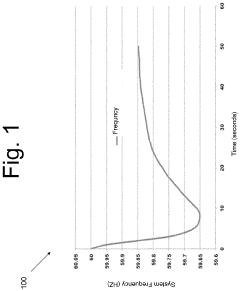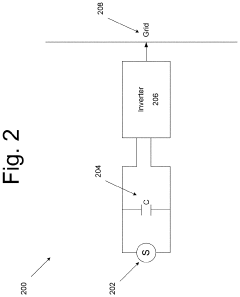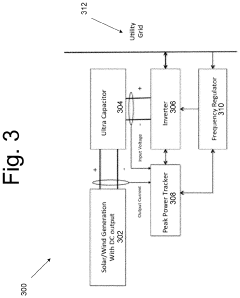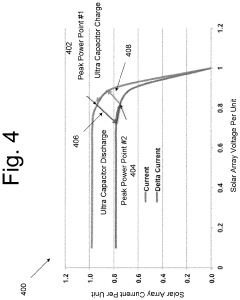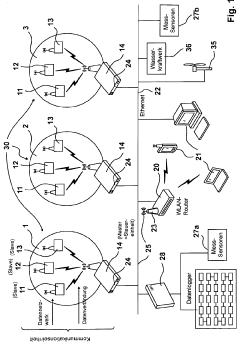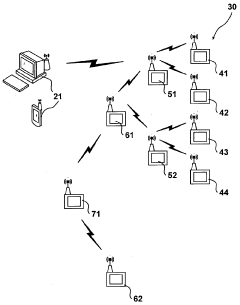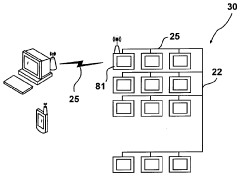Solar Inverter Grid Stability: Challenges and Solutions
JUL 17, 20259 MIN READ
Generate Your Research Report Instantly with AI Agent
Patsnap Eureka helps you evaluate technical feasibility & market potential.
Solar Inverter Evolution and Objectives
Solar inverters have undergone significant evolution since their inception, driven by the rapid growth of solar energy adoption and the increasing need for grid stability. Initially, solar inverters were simple devices designed to convert DC power from solar panels into AC power for household use. However, as solar energy became more prevalent, the focus shifted towards developing more sophisticated inverters capable of supporting grid stability.
The evolution of solar inverters can be traced through several key stages. In the early 2000s, basic grid-tied inverters emerged, allowing excess solar power to be fed back into the grid. This was followed by the introduction of smart inverters in the mid-2000s, which offered improved communication capabilities and basic grid support functions. The next major advancement came with the development of advanced grid-support inverters in the 2010s, featuring enhanced capabilities for voltage and frequency regulation.
Today, state-of-the-art solar inverters are equipped with advanced grid stability features, including reactive power control, low voltage ride-through, and frequency response. These capabilities enable solar systems to actively contribute to grid stability, rather than merely supplying power. The ongoing evolution is now focused on developing inverters with even more advanced grid support functions, improved efficiency, and enhanced cybersecurity measures.
The primary objective in solar inverter development is to address the challenges associated with grid stability as solar energy penetration increases. This includes mitigating voltage fluctuations, managing frequency deviations, and ensuring seamless integration of distributed energy resources. Another key goal is to enhance the resilience of solar systems during grid disturbances, allowing them to remain connected and support grid recovery.
Future objectives for solar inverter technology include developing more intelligent and autonomous systems capable of predictive grid support, improving energy storage integration for enhanced grid services, and advancing communication protocols for better coordination with grid operators. Additionally, there is a growing focus on developing inverters that can adapt to evolving grid codes and standards across different regions, ensuring global compatibility and easier deployment of solar systems.
As the solar energy landscape continues to evolve, the objectives for solar inverter technology are expanding to include support for emerging concepts such as virtual power plants and peer-to-peer energy trading. This requires inverters to become more flexible, interoperable, and capable of participating in complex energy management systems. The ultimate aim is to create a new generation of solar inverters that not only convert power but also serve as intelligent nodes in a decentralized, resilient, and sustainable energy ecosystem.
The evolution of solar inverters can be traced through several key stages. In the early 2000s, basic grid-tied inverters emerged, allowing excess solar power to be fed back into the grid. This was followed by the introduction of smart inverters in the mid-2000s, which offered improved communication capabilities and basic grid support functions. The next major advancement came with the development of advanced grid-support inverters in the 2010s, featuring enhanced capabilities for voltage and frequency regulation.
Today, state-of-the-art solar inverters are equipped with advanced grid stability features, including reactive power control, low voltage ride-through, and frequency response. These capabilities enable solar systems to actively contribute to grid stability, rather than merely supplying power. The ongoing evolution is now focused on developing inverters with even more advanced grid support functions, improved efficiency, and enhanced cybersecurity measures.
The primary objective in solar inverter development is to address the challenges associated with grid stability as solar energy penetration increases. This includes mitigating voltage fluctuations, managing frequency deviations, and ensuring seamless integration of distributed energy resources. Another key goal is to enhance the resilience of solar systems during grid disturbances, allowing them to remain connected and support grid recovery.
Future objectives for solar inverter technology include developing more intelligent and autonomous systems capable of predictive grid support, improving energy storage integration for enhanced grid services, and advancing communication protocols for better coordination with grid operators. Additionally, there is a growing focus on developing inverters that can adapt to evolving grid codes and standards across different regions, ensuring global compatibility and easier deployment of solar systems.
As the solar energy landscape continues to evolve, the objectives for solar inverter technology are expanding to include support for emerging concepts such as virtual power plants and peer-to-peer energy trading. This requires inverters to become more flexible, interoperable, and capable of participating in complex energy management systems. The ultimate aim is to create a new generation of solar inverters that not only convert power but also serve as intelligent nodes in a decentralized, resilient, and sustainable energy ecosystem.
Grid Stability Market Analysis
The global market for grid stability solutions in the context of solar inverters has been experiencing significant growth, driven by the increasing integration of renewable energy sources into power grids worldwide. As solar power generation continues to expand, the need for advanced inverter technologies that can maintain grid stability has become paramount. This market is characterized by a complex interplay of technological advancements, regulatory frameworks, and economic factors.
The demand for grid stability solutions is primarily fueled by the rapid adoption of solar energy in both developed and developing countries. Utility-scale solar installations, in particular, have been a major driver of this market, as they require sophisticated inverter systems to manage large power outputs and ensure seamless integration with existing grid infrastructure. Additionally, the growing trend of distributed solar generation, including residential and commercial rooftop installations, has created a need for smart inverters capable of providing grid support functions at the local level.
Market analysis indicates that the Asia-Pacific region, led by China and India, is currently the largest and fastest-growing market for solar inverter grid stability solutions. This is largely due to ambitious renewable energy targets and substantial government investments in solar power infrastructure. Europe follows closely, with countries like Germany, Spain, and Italy at the forefront of adopting advanced grid stability technologies. The North American market, particularly the United States, is also showing strong growth potential, driven by state-level renewable energy mandates and increasing concerns about grid resilience.
The competitive landscape of the grid stability market for solar inverters is dominated by established power electronics manufacturers and specialized renewable energy technology providers. These companies are investing heavily in research and development to create innovative solutions that address the unique challenges posed by high penetration levels of solar power. Key areas of focus include the development of advanced control algorithms, improved fault ride-through capabilities, and enhanced communication protocols for better grid integration.
Regulatory frameworks play a crucial role in shaping the market for grid stability solutions. Many countries have implemented or are in the process of updating grid codes to require solar inverters to provide ancillary services such as voltage regulation, frequency support, and reactive power control. These regulations are driving the adoption of more sophisticated inverter technologies and creating new market opportunities for companies that can meet these stringent requirements.
The economic aspects of grid stability solutions are also evolving. While the initial cost of advanced inverter systems may be higher, utilities and grid operators are increasingly recognizing the long-term benefits of improved grid stability and reliability. This is leading to a shift in procurement strategies, with a greater emphasis on total cost of ownership and system performance over upfront costs. As a result, the market is seeing a trend towards more value-added services and performance-based contracts in the solar inverter sector.
The demand for grid stability solutions is primarily fueled by the rapid adoption of solar energy in both developed and developing countries. Utility-scale solar installations, in particular, have been a major driver of this market, as they require sophisticated inverter systems to manage large power outputs and ensure seamless integration with existing grid infrastructure. Additionally, the growing trend of distributed solar generation, including residential and commercial rooftop installations, has created a need for smart inverters capable of providing grid support functions at the local level.
Market analysis indicates that the Asia-Pacific region, led by China and India, is currently the largest and fastest-growing market for solar inverter grid stability solutions. This is largely due to ambitious renewable energy targets and substantial government investments in solar power infrastructure. Europe follows closely, with countries like Germany, Spain, and Italy at the forefront of adopting advanced grid stability technologies. The North American market, particularly the United States, is also showing strong growth potential, driven by state-level renewable energy mandates and increasing concerns about grid resilience.
The competitive landscape of the grid stability market for solar inverters is dominated by established power electronics manufacturers and specialized renewable energy technology providers. These companies are investing heavily in research and development to create innovative solutions that address the unique challenges posed by high penetration levels of solar power. Key areas of focus include the development of advanced control algorithms, improved fault ride-through capabilities, and enhanced communication protocols for better grid integration.
Regulatory frameworks play a crucial role in shaping the market for grid stability solutions. Many countries have implemented or are in the process of updating grid codes to require solar inverters to provide ancillary services such as voltage regulation, frequency support, and reactive power control. These regulations are driving the adoption of more sophisticated inverter technologies and creating new market opportunities for companies that can meet these stringent requirements.
The economic aspects of grid stability solutions are also evolving. While the initial cost of advanced inverter systems may be higher, utilities and grid operators are increasingly recognizing the long-term benefits of improved grid stability and reliability. This is leading to a shift in procurement strategies, with a greater emphasis on total cost of ownership and system performance over upfront costs. As a result, the market is seeing a trend towards more value-added services and performance-based contracts in the solar inverter sector.
Current Challenges in Solar Inverter Integration
The integration of solar inverters into the power grid presents several significant challenges that need to be addressed for successful and stable operation. One of the primary issues is the intermittent nature of solar power generation, which can lead to voltage fluctuations and power quality issues. As solar irradiance varies throughout the day due to cloud cover and other environmental factors, the output of solar inverters can change rapidly, potentially causing instability in the grid.
Another major challenge is the lack of inertia in solar inverter systems compared to traditional synchronous generators. Conventional power plants provide mechanical inertia that helps maintain grid frequency stability during disturbances. Solar inverters, being electronic devices, do not inherently provide this inertial response, making it more difficult to maintain grid frequency within acceptable limits during sudden changes in load or generation.
Harmonics and power factor issues also pose significant challenges in solar inverter integration. Inverters can introduce harmonic distortions into the grid, which can affect the performance of other connected equipment and reduce overall power quality. Additionally, maintaining an appropriate power factor becomes more complex with the increasing penetration of solar inverters, as their reactive power capabilities may be limited or not properly coordinated with grid requirements.
The protection and control systems of the grid must also be adapted to accommodate the bidirectional power flow introduced by solar inverters. Traditional protection schemes may not be adequate to handle fault conditions in a grid with high solar penetration, potentially leading to safety issues and reduced reliability.
Furthermore, the geographic concentration of solar installations can create localized grid congestion and voltage regulation problems. In areas with high solar adoption, the grid infrastructure may not be adequately sized to handle the peak power generation during sunny periods, leading to potential overloading and voltage rise issues.
Lastly, the challenge of grid code compliance is becoming increasingly complex as regulations evolve to address the growing penetration of solar power. Inverter manufacturers and system integrators must continually adapt their technologies to meet stringent requirements for fault ride-through capabilities, voltage and frequency support, and other grid-supporting functions. This ongoing process of adaptation and compliance adds technical and economic challenges to the integration of solar inverters into the grid.
Another major challenge is the lack of inertia in solar inverter systems compared to traditional synchronous generators. Conventional power plants provide mechanical inertia that helps maintain grid frequency stability during disturbances. Solar inverters, being electronic devices, do not inherently provide this inertial response, making it more difficult to maintain grid frequency within acceptable limits during sudden changes in load or generation.
Harmonics and power factor issues also pose significant challenges in solar inverter integration. Inverters can introduce harmonic distortions into the grid, which can affect the performance of other connected equipment and reduce overall power quality. Additionally, maintaining an appropriate power factor becomes more complex with the increasing penetration of solar inverters, as their reactive power capabilities may be limited or not properly coordinated with grid requirements.
The protection and control systems of the grid must also be adapted to accommodate the bidirectional power flow introduced by solar inverters. Traditional protection schemes may not be adequate to handle fault conditions in a grid with high solar penetration, potentially leading to safety issues and reduced reliability.
Furthermore, the geographic concentration of solar installations can create localized grid congestion and voltage regulation problems. In areas with high solar adoption, the grid infrastructure may not be adequately sized to handle the peak power generation during sunny periods, leading to potential overloading and voltage rise issues.
Lastly, the challenge of grid code compliance is becoming increasingly complex as regulations evolve to address the growing penetration of solar power. Inverter manufacturers and system integrators must continually adapt their technologies to meet stringent requirements for fault ride-through capabilities, voltage and frequency support, and other grid-supporting functions. This ongoing process of adaptation and compliance adds technical and economic challenges to the integration of solar inverters into the grid.
Grid Stability Solution Landscape
01 Grid stability control methods for solar inverters
Various control methods are implemented in solar inverters to enhance grid stability. These methods include advanced algorithms for voltage and frequency regulation, reactive power compensation, and active power curtailment. By dynamically adjusting the inverter's output based on grid conditions, these techniques help maintain a stable and reliable power supply.- Grid stability control methods: Various control methods are implemented in solar inverters to enhance grid stability. These methods include advanced algorithms for voltage and frequency regulation, reactive power compensation, and active power curtailment. By dynamically adjusting the inverter's output based on grid conditions, these control strategies help maintain grid stability and power quality.
- Fault ride-through capabilities: Solar inverters are designed with fault ride-through capabilities to maintain grid stability during short-term disturbances. These features allow the inverter to remain connected and continue operating under abnormal grid conditions, such as voltage sags or frequency deviations, thereby supporting grid recovery and preventing cascading failures.
- Smart grid integration and communication: Advanced solar inverters incorporate smart grid integration features and communication protocols. These enable real-time data exchange with grid operators, allowing for coordinated control and optimization of distributed energy resources. Such integration enhances overall grid stability by enabling more efficient management of power flow and grid resources.
- Energy storage integration: Solar inverters are increasingly designed to integrate with energy storage systems. This combination allows for better management of intermittent solar power generation, providing grid services such as peak shaving, load shifting, and frequency regulation. The integration of storage enhances the stability and reliability of the grid by smoothing out fluctuations in solar power output.
- Advanced forecasting and predictive control: Solar inverters incorporate advanced forecasting techniques and predictive control algorithms to anticipate changes in solar power generation and grid conditions. These features enable proactive adjustments to inverter settings and output, helping to maintain grid stability by minimizing sudden fluctuations and improving overall system responsiveness.
02 Integration of energy storage systems with solar inverters
Combining energy storage systems with solar inverters improves grid stability by providing a buffer for power fluctuations. These hybrid systems can store excess energy during peak production periods and release it during high demand or low production times, effectively smoothing out the power output and reducing stress on the grid.Expand Specific Solutions03 Smart grid communication and coordination
Advanced communication protocols and coordination systems are implemented to enable solar inverters to interact with the smart grid. This allows for real-time monitoring, data exchange, and coordinated responses to grid events, enhancing overall stability and efficiency of the power distribution system.Expand Specific Solutions04 Fault ride-through capabilities for solar inverters
Solar inverters are equipped with fault ride-through capabilities to maintain grid connection during short-term disturbances. These features allow the inverters to continue operating or quickly recover from voltage sags, frequency variations, and other grid anomalies, thereby contributing to overall grid stability.Expand Specific Solutions05 Adaptive control and machine learning for grid stability
Innovative adaptive control systems and machine learning algorithms are incorporated into solar inverters to optimize their performance for grid stability. These technologies enable the inverters to learn from historical data, predict grid behavior, and proactively adjust their operation to maintain stability under varying conditions.Expand Specific Solutions
Key Solar Inverter Manufacturers
The solar inverter grid stability market is in a growth phase, driven by increasing renewable energy adoption and grid modernization efforts. The market size is expanding rapidly, with projections indicating significant growth in the coming years. Technologically, solar inverter grid stability solutions are advancing, but still face challenges in managing high penetration of distributed energy resources. Key players like SMA Solar Technology, Huawei Digital Power, and Siemens are leading innovation in this space, developing advanced grid-support features and smart inverter technologies. Universities such as Huazhong University of Science & Technology and Chongqing University are contributing to research and development efforts, while companies like Toshiba and Schneider Electric are leveraging their power systems expertise to address grid stability issues.
SMA Solar Technology AG
Technical Solution: SMA Solar Technology AG has developed advanced grid-forming inverter technology to address solar inverter grid stability challenges. Their solution includes the SMA Sunny Central Storage UP inverter, which can provide grid-forming capabilities in large-scale solar and storage plants. This inverter can operate in grid-following or grid-forming mode, allowing for seamless transition between the two [1]. The system utilizes virtual synchronous generator (VSG) technology to mimic the behavior of traditional synchronous generators, providing inertia and improving grid stability [2]. SMA's inverters also incorporate advanced grid management functions such as dynamic grid support, fault ride-through capabilities, and reactive power control to maintain grid stability under various conditions [3].
Strengths: Proven technology in large-scale projects, versatile grid-forming capabilities, and advanced grid management functions. Weaknesses: May require additional energy storage systems for optimal performance, potentially higher initial costs compared to traditional inverters.
Siemens Corp.
Technical Solution: Siemens has developed a comprehensive solution for solar inverter grid stability challenges through its SICAM microgrid controller and Sinamics inverter technology. The SICAM microgrid controller provides advanced grid management capabilities, including real-time monitoring, forecasting, and control of distributed energy resources [4]. Siemens' grid-forming inverters utilize advanced control algorithms to provide synthetic inertia, voltage and frequency regulation, and fault ride-through capabilities [5]. The company's solution also incorporates machine learning and AI techniques to optimize grid stability and power quality in real-time, adapting to changing grid conditions and renewable energy penetration levels [6].
Strengths: Integrated solution combining hardware and software, advanced AI-driven optimization, and extensive experience in grid infrastructure. Weaknesses: Potentially complex implementation and integration with existing systems, may require significant investment for full functionality.
Innovative Grid Support Features
Solar and/or wind inverter
PatentActiveUS10916944B2
Innovation
- Incorporating an ultracapacitor connected in parallel between a power source and an inverter, which supplies power during frequency disturbances and is quickly recharged during normal operations, allowing the inverter to stabilize the grid frequency by adjusting its output based on grid frequency changes.
Inverter for power supply system feeding into an ac power supply system
PatentWO2008138288A1
Innovation
- A network of inverters connected via data communication forms a communication unit with a master-slave hierarchy, allowing for centralized control and monitoring, reducing the need for additional modules and enabling rapid regulation of semiconductor inverters, thereby optimizing energy utilization and grid stability.
Regulatory Framework for Grid-Tied Inverters
The regulatory framework for grid-tied inverters plays a crucial role in ensuring the stability and reliability of power grids as solar energy integration continues to grow. These regulations are designed to address the unique challenges posed by distributed energy resources and maintain the overall integrity of the electrical system.
At the international level, organizations such as the International Electrotechnical Commission (IEC) have developed standards like IEC 61727 and IEC 62116, which provide guidelines for the interconnection of photovoltaic systems with the utility grid. These standards outline requirements for power quality, voltage regulation, and anti-islanding protection, among other critical aspects of grid-tied inverter operation.
In the United States, the Institute of Electrical and Electronics Engineers (IEEE) has established the IEEE 1547 standard, which serves as a comprehensive framework for interconnecting distributed energy resources with electric power systems. This standard addresses issues such as voltage regulation, power quality, and islanding detection, providing a foundation for state and local regulations.
The European Union has implemented its own set of regulations, including the EN 50438 standard, which specifies requirements for micro-generation installations to be connected in parallel with public low-voltage distribution networks. Additionally, individual countries within the EU have developed their own grid codes to address specific national requirements.
Grid operators and utilities often impose additional requirements on grid-tied inverters to ensure compatibility with their specific network characteristics. These may include specifications for reactive power control, frequency response, and fault ride-through capabilities. Such requirements are typically outlined in interconnection agreements between system owners and utilities.
As the penetration of solar energy increases, regulatory bodies are continually updating their frameworks to address emerging challenges. For instance, recent updates to grid codes in many jurisdictions now require advanced grid support functions from inverters, such as dynamic voltage support and frequency regulation.
Compliance with these regulations is typically verified through certification processes, where inverters are tested by accredited laboratories to ensure they meet the required standards. This certification is often a prerequisite for grid connection approval, providing assurance to utilities and grid operators that the inverters will not compromise system stability.
The regulatory landscape for grid-tied inverters is dynamic, with ongoing efforts to harmonize standards across different regions and adapt to the evolving needs of modern power systems. As such, manufacturers and system integrators must stay informed about regulatory changes and ensure their products remain compliant with the latest requirements to support the continued growth of solar energy integration.
At the international level, organizations such as the International Electrotechnical Commission (IEC) have developed standards like IEC 61727 and IEC 62116, which provide guidelines for the interconnection of photovoltaic systems with the utility grid. These standards outline requirements for power quality, voltage regulation, and anti-islanding protection, among other critical aspects of grid-tied inverter operation.
In the United States, the Institute of Electrical and Electronics Engineers (IEEE) has established the IEEE 1547 standard, which serves as a comprehensive framework for interconnecting distributed energy resources with electric power systems. This standard addresses issues such as voltage regulation, power quality, and islanding detection, providing a foundation for state and local regulations.
The European Union has implemented its own set of regulations, including the EN 50438 standard, which specifies requirements for micro-generation installations to be connected in parallel with public low-voltage distribution networks. Additionally, individual countries within the EU have developed their own grid codes to address specific national requirements.
Grid operators and utilities often impose additional requirements on grid-tied inverters to ensure compatibility with their specific network characteristics. These may include specifications for reactive power control, frequency response, and fault ride-through capabilities. Such requirements are typically outlined in interconnection agreements between system owners and utilities.
As the penetration of solar energy increases, regulatory bodies are continually updating their frameworks to address emerging challenges. For instance, recent updates to grid codes in many jurisdictions now require advanced grid support functions from inverters, such as dynamic voltage support and frequency regulation.
Compliance with these regulations is typically verified through certification processes, where inverters are tested by accredited laboratories to ensure they meet the required standards. This certification is often a prerequisite for grid connection approval, providing assurance to utilities and grid operators that the inverters will not compromise system stability.
The regulatory landscape for grid-tied inverters is dynamic, with ongoing efforts to harmonize standards across different regions and adapt to the evolving needs of modern power systems. As such, manufacturers and system integrators must stay informed about regulatory changes and ensure their products remain compliant with the latest requirements to support the continued growth of solar energy integration.
Environmental Impact Assessment
The environmental impact of solar inverters and their role in grid stability is a crucial aspect to consider in the broader context of renewable energy adoption. While solar power is generally regarded as a clean energy source, the production, operation, and disposal of solar inverters can have both positive and negative environmental implications.
One of the primary environmental benefits of solar inverters is their contribution to reducing greenhouse gas emissions. By enabling the integration of solar energy into the power grid, inverters play a vital role in decreasing reliance on fossil fuels for electricity generation. This shift towards renewable energy sources helps mitigate climate change and improve air quality in urban areas.
However, the manufacturing process of solar inverters involves the use of various materials, including metals, plastics, and electronic components. The extraction and processing of these raw materials can have environmental consequences, such as habitat destruction, water pollution, and energy consumption. Additionally, the production of inverters requires energy, which may come from non-renewable sources, potentially offsetting some of the environmental benefits.
The operational phase of solar inverters generally has a minimal direct environmental impact. These devices are designed to operate efficiently and quietly, with minimal emissions or waste production. However, the heat generated by inverters during operation may contribute to local temperature increases, particularly in large-scale solar installations.
End-of-life disposal of solar inverters presents another environmental challenge. As electronic devices, inverters contain components that may be harmful to the environment if not properly disposed of or recycled. Proper recycling and waste management practices are essential to minimize the environmental impact of decommissioned inverters and recover valuable materials.
In terms of grid stability, solar inverters play a crucial role in managing the intermittent nature of solar power generation. Advanced inverter technologies can help smooth out power fluctuations, provide reactive power support, and enhance overall grid resilience. These capabilities contribute to a more stable and efficient power system, potentially reducing the need for additional fossil fuel-based backup generation and associated environmental impacts.
The development of smart grid technologies and advanced inverter functionalities can further enhance the environmental benefits of solar power systems. By enabling better integration of renewable energy sources and improving overall grid efficiency, these technologies can lead to reduced energy losses and more effective utilization of clean energy resources.
In conclusion, while solar inverters contribute significantly to the environmental benefits of solar energy, their lifecycle environmental impact must be carefully managed. Continued research and development in inverter technology, coupled with responsible manufacturing and recycling practices, will be crucial in maximizing the positive environmental outcomes of solar power integration and grid stability solutions.
One of the primary environmental benefits of solar inverters is their contribution to reducing greenhouse gas emissions. By enabling the integration of solar energy into the power grid, inverters play a vital role in decreasing reliance on fossil fuels for electricity generation. This shift towards renewable energy sources helps mitigate climate change and improve air quality in urban areas.
However, the manufacturing process of solar inverters involves the use of various materials, including metals, plastics, and electronic components. The extraction and processing of these raw materials can have environmental consequences, such as habitat destruction, water pollution, and energy consumption. Additionally, the production of inverters requires energy, which may come from non-renewable sources, potentially offsetting some of the environmental benefits.
The operational phase of solar inverters generally has a minimal direct environmental impact. These devices are designed to operate efficiently and quietly, with minimal emissions or waste production. However, the heat generated by inverters during operation may contribute to local temperature increases, particularly in large-scale solar installations.
End-of-life disposal of solar inverters presents another environmental challenge. As electronic devices, inverters contain components that may be harmful to the environment if not properly disposed of or recycled. Proper recycling and waste management practices are essential to minimize the environmental impact of decommissioned inverters and recover valuable materials.
In terms of grid stability, solar inverters play a crucial role in managing the intermittent nature of solar power generation. Advanced inverter technologies can help smooth out power fluctuations, provide reactive power support, and enhance overall grid resilience. These capabilities contribute to a more stable and efficient power system, potentially reducing the need for additional fossil fuel-based backup generation and associated environmental impacts.
The development of smart grid technologies and advanced inverter functionalities can further enhance the environmental benefits of solar power systems. By enabling better integration of renewable energy sources and improving overall grid efficiency, these technologies can lead to reduced energy losses and more effective utilization of clean energy resources.
In conclusion, while solar inverters contribute significantly to the environmental benefits of solar energy, their lifecycle environmental impact must be carefully managed. Continued research and development in inverter technology, coupled with responsible manufacturing and recycling practices, will be crucial in maximizing the positive environmental outcomes of solar power integration and grid stability solutions.
Unlock deeper insights with Patsnap Eureka Quick Research — get a full tech report to explore trends and direct your research. Try now!
Generate Your Research Report Instantly with AI Agent
Supercharge your innovation with Patsnap Eureka AI Agent Platform!
